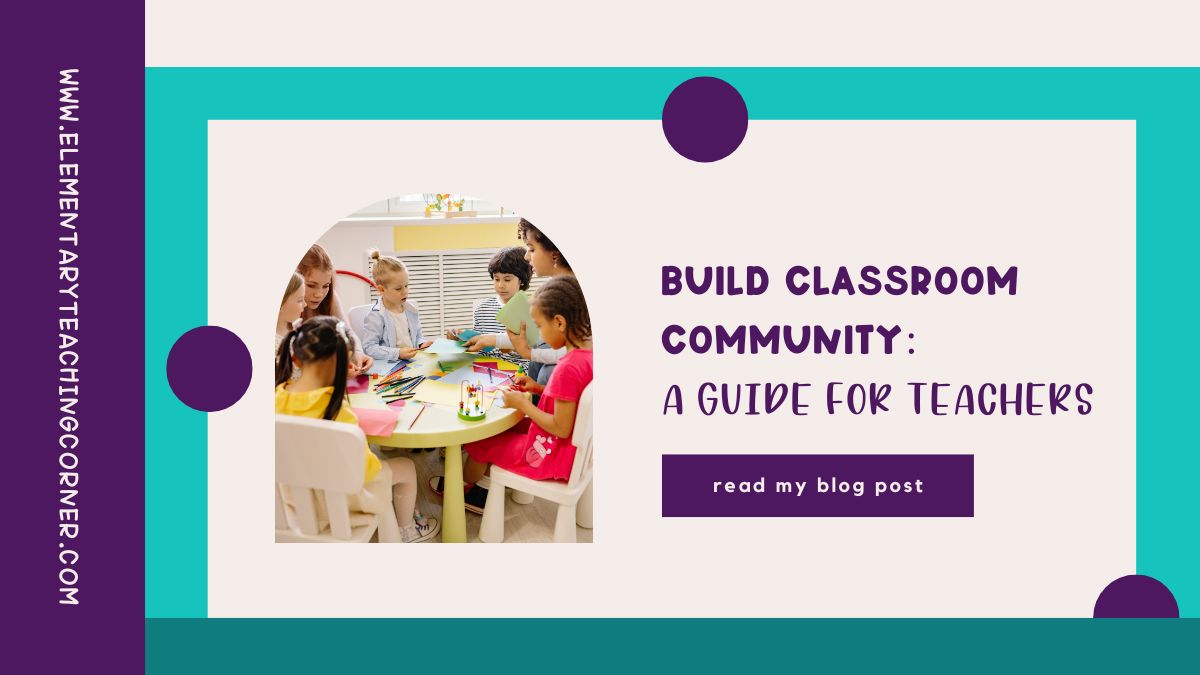Welcome, educators, to the world of classroom community-building! As an experienced Elementary Education teacher, I am thrilled to share my insights on creating a vibrant, engaging, and inclusive learning environment. Building a strong classroom community is the cornerstone of successful teaching, as it fosters a sense of belonging, enhances students’ social and emotional development, and promotes a joyful atmosphere where students love to learn. In this blog post, we will explore various activities, games, and strategies that will empower you to build a classroom community that students will cherish for a lifetime.
Primary (Kindergarten through Second Grade):
In the early years of schooling, building a classroom community lays the foundation for a positive and nurturing learning environment. Young learners thrive in a warm and inviting atmosphere where they feel safe to express themselves. Implement activities like “All About Me” collages, where students create colorful displays of their interests and hobbies, to encourage self-expression and bonding. Use storytime to introduce characters with diverse backgrounds and experiences, fostering empathy and understanding among the little ones. Emphasize the importance of kindness and sharing through games like “Pass the Smile” or “Kindness Catcher.” By cultivating a caring and supportive community, you set the stage for a joyful educational journey filled with exploration and discovery.
Upper Elementary (Third through Fifth Grade):
In upper elementary, building a strong classroom community takes on a deeper significance as students develop more complex social and emotional skills. As they navigate the challenges of upper elementary, a supportive community becomes the backbone that empowers them to face academic and personal growth with confidence. Engage students in team-building projects that require group decision-making, helping them understand the importance of compromise and cooperation. Encourage open discussions and collaborative problem-solving activities that allow students to voice their opinions respectfully. Foster leadership skills by assigning classroom responsibilities, such as line leader or class monitor. These opportunities to take ownership foster a sense of accountability and unity within the classroom, laying the foundation for a successful learning environment.
The start of a new school year is such an important time. You can also check out our post on Teacher Best Practices for the Beginning of the Year! Click here to check out that post.
The Power of Classroom Community
Embracing the Magic of Connection
In the bustling world of education, we sometimes overlook the enchanting magic that a close-knit classroom community can bring. A strong community encourages students to feel valued and appreciated, leading to increased motivation and engagement. It creates a safe space where children are encouraged to express themselves, share ideas, and collaborate freely. Imagine a classroom where students eagerly raise their hands to participate and eagerly contribute to discussions, all because they feel an unbreakable bond with their peers and teacher.
Building a classroom community goes beyond just academic success; it prepares students for the real world, where teamwork, empathy, and communication skills are paramount. When children know they are part of something special, they develop self-confidence and a willingness to take risks, which are essential for personal growth.
Primary (Kindergarten through Second Grade):
In the early years, building a classroom community lays the foundation for a positive and nurturing learning environment. Focus on activities that promote friendship and sharing, such as “Friendship Circle” time, where students share something they appreciate about their peers. Emphasize the value of kindness through read-alouds and puppet plays that highlight empathy and caring for others. Foster a sense of belonging by creating a classroom family where students feel safe to explore, learn, and have fun together. By nurturing a strong classroom community, you will set the stage for a joyful and successful educational journey.
Upper Elementary (Third through Fifth Grade):
In upper elementary, students enjoy activities that challenge their critical thinking and creativity. Consider incorporating team-building escape room challenges where students work together to solve puzzles and riddles. Engage them in collaborative STEM projects that require brainstorming, designing, and testing. For example, building a functional bridge using specific materials to hold a designated weight. These activities not only foster camaraderie but also strengthen their problem-solving and communication skills, setting the stage for successful learning and collaboration in their later years.
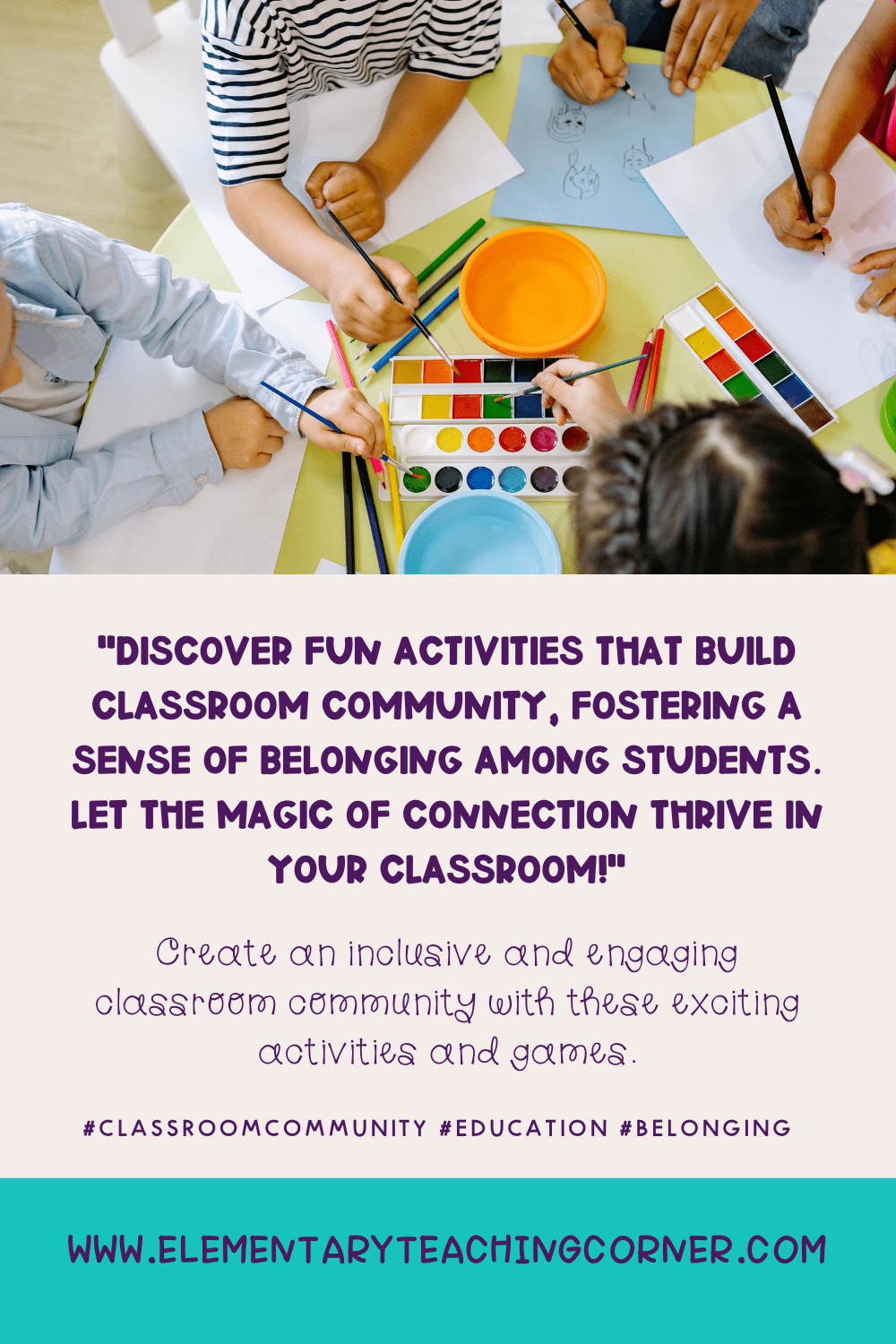
Activities that Form Strong Bonds and Build Classroom Community
Icebreaker Extravaganza: Getting to Know You
The first days of school set the stage for the entire year. Therefore, I always kickstart the school year with a delightful icebreaker extravaganza. One of my favorite activities is “Two Truths and a Dream.” Students take turns sharing two true facts about themselves and one aspiration they dream of accomplishing. Not only does this activity encourage sharing, but it also creates an atmosphere of excitement as students learn fascinating details about their peers.
Primary (Kindergarten through Second Grade):
For the little ones, activities that focus on fun and play are essential for building a strong classroom community. Arrange interactive play centers where students can engage in imaginative role-playing together. Conduct “Show and Tell” sessions to boost confidence and promote sharing among young learners. Introduce cooperative games like “Rainbow Snakes” or “Magic Carpet Ride” that involve working together towards a common goal. By infusing playfulness into their interactions, you will create a positive and joyful atmosphere where friendships flourish.
Upper Elementary (Third through Fifth Grade):
In upper elementary, students enjoy activities that challenge their critical thinking and creativity. Consider incorporating team-building escape room challenges where students work together to solve puzzles and riddles. Engage them in collaborative STEM projects that require brainstorming, designing, and testing. For example, building a functional bridge using specific materials to hold a designated weight. These activities not only foster camaraderie but also strengthen their problem-solving and communication skills, setting the stage for successful learning and collaboration in their later years.
Gratitude Garden: Cultivating Kindness to Build Classroom Community
Practicing gratitude is a beautiful way to nurture empathy and kindness within the classroom community. I create a “Gratitude Garden” bulletin board, where students can write notes of appreciation for their classmates. Encouraging students to recognize the unique strengths and efforts of others instills a culture of positivity and support. Witnessing the garden bloom with colorful notes is heartwarming and reminds us all of the importance of spreading kindness.
Primary (Kindergarten – 2nd) Gratitude Garden: Spreading Seeds of Kindness
In the bustling world of education, teaching kindness and gratitude is as essential as teaching academics. One wonderful activity that nurtures empathy and compassion in primary elementary (kindergarten through second grade) is the “Gratitude Garden.” Create a colorful and interactive bulletin board in the shape of a garden, where students can express their appreciation for one another. Provide flower-shaped sticky notes and markers for students to write kind messages to their peers, acknowledging acts of kindness or simply offering words of encouragement. As the gratitude garden blooms with heartfelt notes, students will learn the power of kindness and its positive impact on their classroom community.
Upper Elementary (Third through Fifth Grade) Gratitude Journal: A Daily Reflection
In upper elementary (third through fifth grade), a gratitude journal can be an excellent way to foster a positive and appreciative classroom community. Encourage students to keep a gratitude journal where they jot down things they are thankful for each day. This practice helps them focus on the positive aspects of their lives and builds a habit of looking for kindness and joy in their surroundings. At the end of the week, students can share their reflections, fostering a culture of gratitude and mutual appreciation within the classroom. As they witness the power of gratitude, students will develop a deeper connection with one another, creating a supportive and caring community that celebrates every small gesture of kindness.

Section 3: How to Build Classroom Community
Morning Meetings: A Daily Dose of Connection
One of the most effective ways to build a strong classroom community is through daily morning meetings. Gather your students in a circle and kickstart the day with smiles, greetings, and sharing. Encourage students to discuss their interests, hobbies, or weekend adventures, and prompt them to ask questions of their peers. This routine promotes active listening, empathy, and peer-to-peer connections.
Primary (Kindergarten through Second Grade)
In the early years, morning meetings serve as a precious time for young learners to practice communication and social skills. Create a daily routine that includes a friendly greeting and a simple sharing activity, like discussing their favorite color or animal. Use storytelling and picture books to explore themes of friendship and cooperation. Engage students in interactive activities like “I Spy” or “Guess the Sound,” where they take turns describing objects or making animal noises. These delightful morning meetings set a positive tone for the day and establish a sense of belonging within the classroom.
Upper Elementary (Third through Fifth Grade)
In upper elementary, morning meetings take on a more mature and interactive approach. Use morning meetings as an opportunity for students to voice their thoughts and ideas about classroom matters. Encourage them to share goals and aspirations for the day or week, fostering a sense of accountability and motivation. Introduce thought-provoking questions and discussion topics that stimulate critical thinking and self-awareness. As students actively participate in morning meetings, they build stronger connections with each other, enhancing the overall classroom community.
Collaborative Classrooms: Together We Thrive When We Build Classroom Community
A classroom that fosters collaboration is a classroom that thrives. Encourage group projects and team activities that require students to work together towards a common goal. Assign roles within the group, allowing each student to contribute their unique strengths. Whether they are solving a challenging math problem or creating an art project, students will learn to rely on each other, building trust and camaraderie in the process.
Games that Unite the Class
Community Bingo: Uniting through Shared Interests
Community Bingo is a delightful game that encourages students to find peers with shared interests and experiences. Create personalized bingo cards for each student with fun facts about themselves. Students then interact with their classmates, trying to find someone who fits each description. This game sparks lively conversations and uncovers surprising commonalities, strengthening the bonds of the classroom community.
Primary (Kindergarten through Second Grade)
For young learners, Community Bingo is a fun and interactive way to discover similarities among peers. Create bingo cards with simple illustrations representing favorite toys, activities, or family members. During the game, encourage students to ask questions to find a matching classmate. As they interact and discover shared interests, friendships blossom, creating a sense of belonging within the classroom.
Upper Elementary (Third through Fifth Grade)
In upper elementary, Community Bingo can be adapted to include more nuanced interests and hobbies. Create bingo cards with diverse categories, such as favorite books, extracurricular activities, or dream careers. As students explore each other’s passions, they forge deeper connections and gain a greater understanding of their peers. This game becomes a bridge to embracing diverse perspectives and nurturing an inclusive classroom community.
Compliment Circle: Uplifting Spirits and Help Build Classroom Community
The Compliment Circle is a heartwarming activity that reinforces positive reinforcement and boosts self-esteem. Sit your students in a circle and have each child give a genuine compliment to the person on their right. This chain of compliments continues until each student has been appreciated. The joy and warmth that fill the room during this activity are palpable, and it leaves a lasting impression on the students’ hearts.
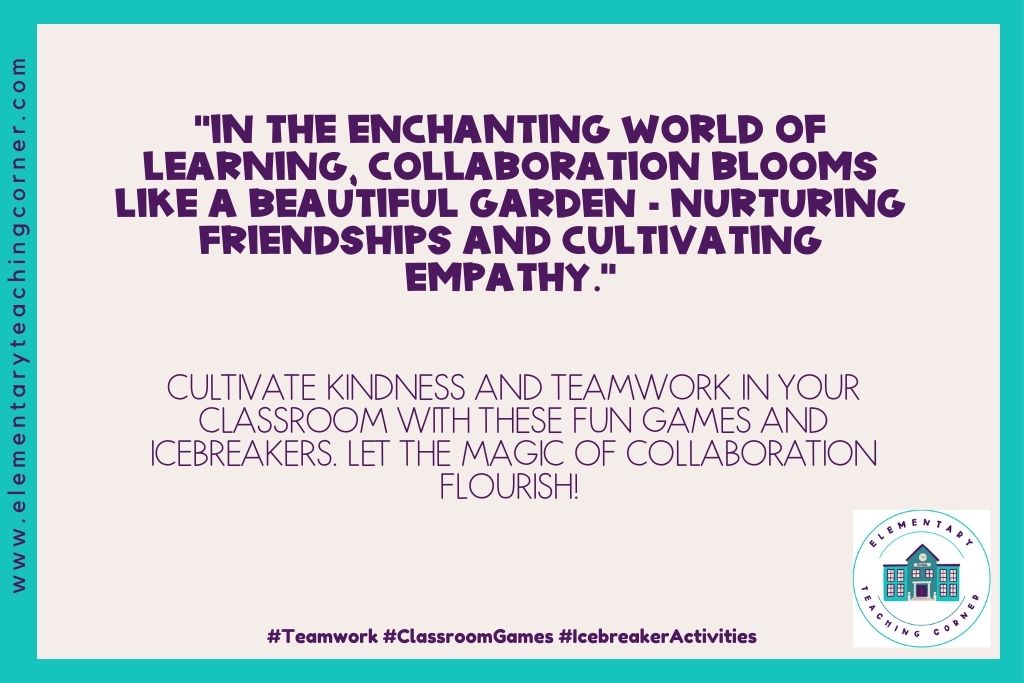
Nurturing Inclusivity and Build Classroom Community
Celebrating Diversity: Embracing Differences
In a diverse classroom, embracing differences is key to building an inclusive community. Celebrate cultural events, holidays, and traditions from around the world. Encourage students to share their customs and experiences, fostering an atmosphere of respect and appreciation. This practice teaches children to be open-minded and accepting, nurturing a community that cherishes every individual’s uniqueness.
Inclusive Classroom Norms: Everyone’s Voice Matters
Creating inclusive classroom norms is essential to ensure that every student feels heard and valued. Set ground rules together as a class, involving students in establishing guidelines for respectful communication and active listening. By empowering students to contribute to the creation of these norms, they take ownership of the classroom culture and become active participants in maintaining a harmonious environment.
Primary (Kindergarten through Second Grade)
In the early years, introduce diverse picture books and engaging activities that highlight various cultures and traditions. Celebrate holidays from different countries, such as Diwali, Hanukkah, or Chinese New Year, with crafts and stories. Incorporate music and dance from around the world, inviting students to join in the celebration. By exposing young learners to diverse experiences, you create a classroom that celebrates each child’s background and fosters an inclusive and accepting environment.
Upper Elementary (Third through Fifth Grade)
Encourage students to take the lead in celebrating diversity. Organize cultural exploration days where students can share their family heritage, traditional foods, or artifacts. Initiate cross-cultural exchanges with pen-pals from other regions or countries, fostering global connections. Involve students in planning and executing events that showcase the rich tapestry of their classroom community. Embrace diversity as a source of strength and knowledge, and watch as students develop a deep appreciation for each other’s backgrounds, building a resilient and accepting community.
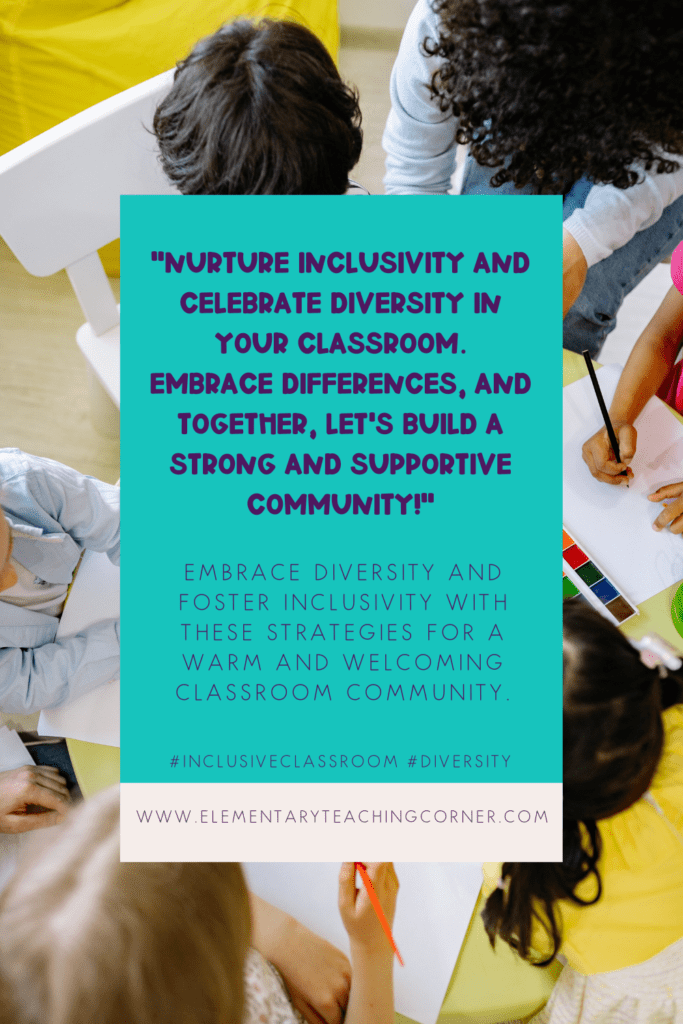
Involve the Community
Family Involvement: The Village Approach
Building a classroom community extends beyond the four walls of the school. Involve families and the local community in various events and projects. Organize family-oriented activities like potluck dinners, storytelling sessions, or school fairs. Engaging parents and guardians in the learning process fosters a sense of partnership between home and school, promoting a thriving community that supports each child’s growth.
Family involvement is a cornerstone of a successful classroom community. Engage parents and guardians in various aspects of your classroom, such as volunteering for special projects or chaperoning field trips. Host family events and workshops to showcase student achievements and provide opportunities for families to connect with one another. When parents are actively involved in the classroom, students feel a stronger sense of support and appreciation, leading to increased motivation and academic success.
Primary (Kindergarten through Second Grade):
In the early years, family involvement can be a heartwarming experience for young learners. Organize cozy family reading nights where students and their families can enjoy books together. Create collaborative art projects that involve parents and guardians, fostering a shared sense of pride in the classroom community. Invite family members to share their cultural traditions or personal stories during “Family Show and Tell” sessions, nurturing a bond that goes beyond the classroom walls.
Upper Elementary (Third through Fifth Grade)
In upper elementary, family involvement takes on a more collaborative and partnership-driven approach. Initiate “Career Day” events where parents can showcase their professions and share insights about their career paths. Collaborate with families on student-led conferences, giving students the opportunity to take ownership of their learning progress. Provide opportunities for families to participate in school-wide events, like talent shows or fundraisers. By actively involving families, you reinforce the notion that building a strong classroom community is a joint effort that extends beyond the school gates.
Community Projects: Making a Difference Together
Engage your students in community service projects that allow them to give back to society. Whether it’s a neighborhood cleanup, collecting donations for a local charity, or writing letters to senior citizens, involving students in meaningful projects strengthens their sense of responsibility and compassion. These experiences encourage students to see the world beyond their classroom and instill a lifelong desire to make a positive impact.
Primary(Kindergarten through Second Grade)
Involving families in the classroom community nurtures a sense of belonging for young learners. Host family breakfasts where students can showcase their projects and achievements to their loved ones. Plan family field trips to nearby attractions or nature parks, encouraging parents to participate in the learning journey. Provide take-home activities that involve families, such as “Weekend Science Experiments” or “Family Reading Challenges.” By embracing the village approach, you strengthen the bond between school and home, creating a collaborative and supportive community.
Upper Elementary (Third through Fifth Grade)
Encourage families to participate in community service projects alongside students. Organize charity drives or volunteer opportunities that involve both students and their families. Collaborate with local businesses or organizations to host career days, where parents can share their professions with the class. Strengthen the sense of community by inviting families to share their unique skills or expertise through interactive workshops. With active family involvement, students gain a broader perspective of the world and a greater appreciation for the interconnectedness of their community.
Cultivating a Growth Mindset
Embracing Challenges: The Power of “Yet”
Fostering a growth mindset within the classroom community empowers students to embrace challenges with enthusiasm and perseverance. Encourage students to use the word “yet” when they encounter difficulties. For example, “I haven’t mastered long division yet.” This simple shift in language reminds students that progress takes time and effort, and it’s all part of the learning journey. With a growth mindset, students become resilient and open to learning from mistakes.
Celebrating Effort: Success in Progress
In a community that values effort, each step forward becomes a cause for celebration. Praise students not only for their achievements but also for their hard work and determination. Acknowledge progress, no matter how small, and reinforce the idea that effort is the gateway to success. When students see that their endeavors are appreciated, they are motivated to continue striving for greatness.
Mindfulness Moments: Nurturing Emotional Well-being
In a fast-paced world, it is essential to prioritize emotional well-being within the classroom community. Incorporate mindfulness moments into the daily routine, encouraging students to pause, breathe, and reflect. Use mindfulness exercises like guided meditation or deep breathing techniques to promote self-awareness and reduce stress. Creating a classroom where students feel emotionally grounded fosters empathy and understanding, laying the groundwork for a compassionate and resilient community.
Primary(Kindergarten through Second Grade):
For young learners, mindfulness moments can be introduced through playful and imaginative activities. Use “Mindful Storytime” where students listen to calming stories that emphasize emotions and self-regulation. Conduct “Emotion Check-ins,” where students use visual aids to express how they feel, fostering emotional vocabulary. Practice mindful movement with activities like “Yoga for Kids” or “Mindful Dance,” encouraging young students to connect with their bodies and emotions.
Upper Elementary (Third through Fifth Grade)
In upper elementary, mindfulness moments can be integrated into academic lessons and transitions. Incorporate mindful reflection exercises after group activities, encouraging students to assess their collaboration and communication skills. Conduct “Gratitude Journals” where students write down things they are thankful for, promoting a positive outlook and appreciation for one another. Introduce growth mindset discussions, emphasizing the power of perseverance and resilience. By embedding mindfulness into the daily routine, you cultivate an emotionally intelligent classroom community that thrives on understanding and support.
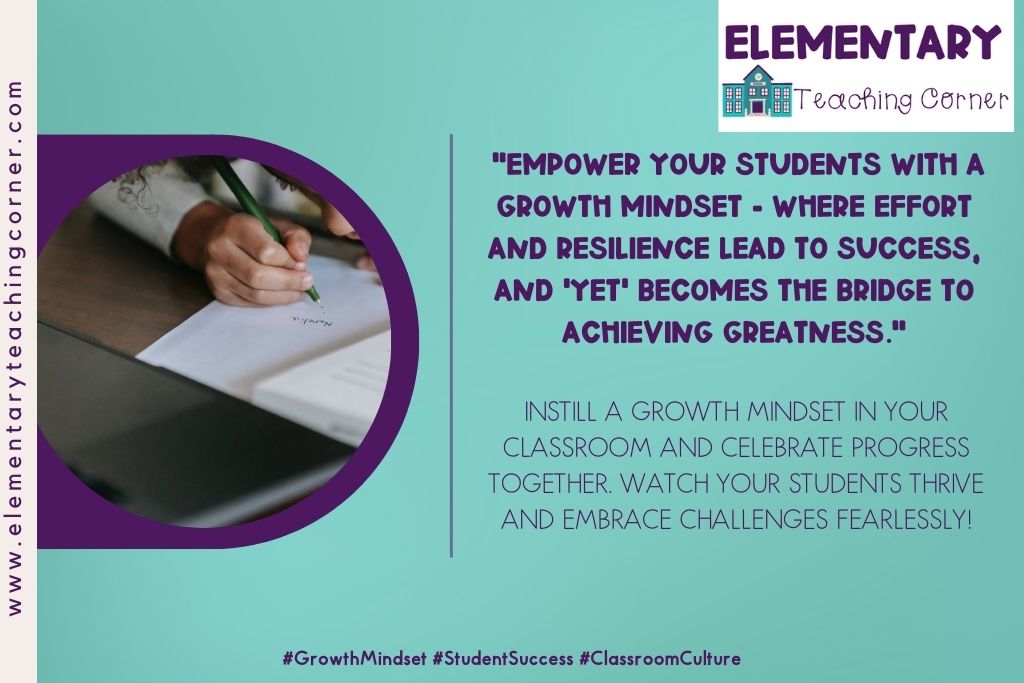
Harnessing Technology for Community-Building
Digital Show-and-Tell: A Modern Twist
Integrate technology into classroom community-building activities by hosting a Digital Show-and-Tell. Encourage students to share photos or videos of their hobbies, interests, or pets with the class. This activity is an excellent opportunity for students to bond over common passions and discover new interests, even if they are from different backgrounds. Embrace the digital world to create connections that transcend the physical boundaries of the classroom.
Online Class Forums: Virtual Collaboration
Set up online class forums where students can engage in discussions and share ideas beyond regular classroom hours. This platform allows shy students to express themselves comfortably and promotes continuous collaboration among peers. Encourage students to ask questions, give feedback, and offer support to one another. The virtual space becomes an extension of the classroom community, fostering a strong sense of camaraderie.
Interactive Technology: Strengthening Classroom Connections
In the digital age, technology can play a powerful role in enhancing classroom community-building. Embrace interactive platforms and apps that promote collaboration and communication among students. Virtual classrooms can foster connectivity, even when students are physically apart. Use tools like virtual whiteboards or collaborative document editors to facilitate group projects and brainstorming sessions. By incorporating technology thoughtfully, you create a dynamic and inclusive learning environment that engages students on multiple levels.
Primary (Kindergarten through Second Grade)
For young learners, interactive technology can be a gateway to creativity and exploration. Utilize educational apps that encourage problem-solving, storytelling, and artistic expression. Conduct virtual field trips to different parts of the world, immersing students in diverse cultures and landscapes. Engage in live video calls with pen-pals from other countries, allowing young students to form global connections. By incorporating interactive technology, you make learning a joyful and interactive experience for the little ones.
Upper Elementary (Third through Fifth Grade)
In upper elementary, technology can be utilized for collaborative learning and effective communication. Implement digital discussion forums where students can exchange ideas, ask questions, and engage in debates on various topics. Use online polling tools to gather student feedback and opinions, promoting active participation and a sense of influence within the classroom. Leverage technology for project-based learning, where students can research, collaborate, and present their findings using multimedia tools. By harnessing the potential of interactive technology, you foster a tech-savvy classroom community that prepares students for the digital age.
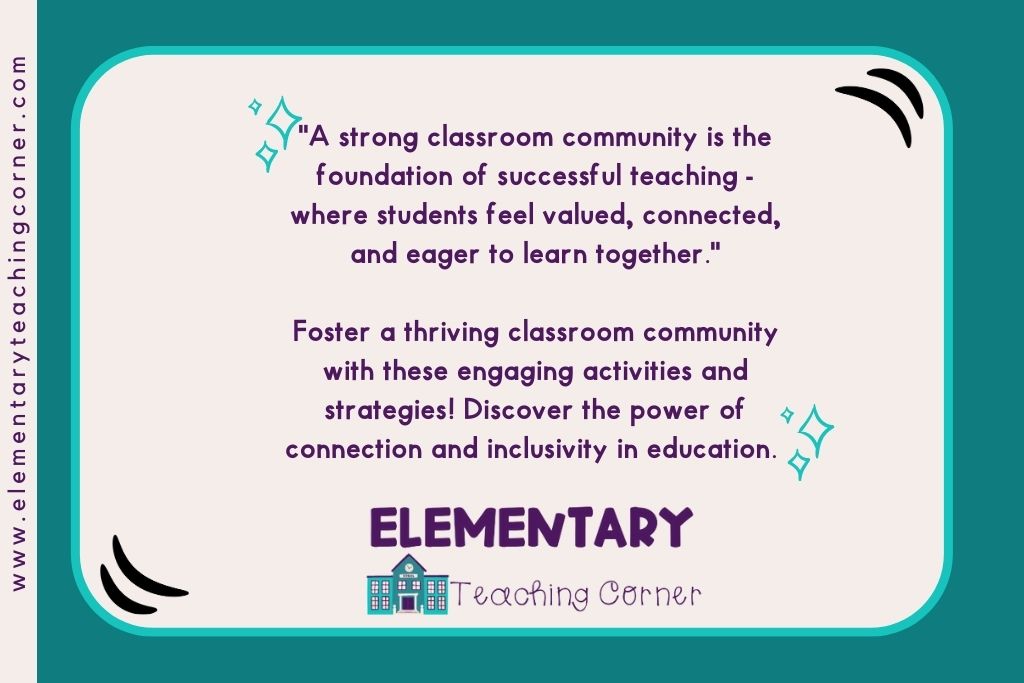
Reflecting and Growing Together to Build Classroom Community
Community Reflection Time: Learning from Each Other
Periodically, set aside time for community reflection. Gather in a circle and encourage students to share their thoughts on how the classroom community is evolving. What activities did they enjoy the most? What improvements could be made? What are their aspirations for the community in the future? This reflective practice allows students to take ownership of their classroom experience and be active participants in its growth.
Community Growth Journal: A Collective Story
Create a Community Growth Journal, where students jot down their observations, reflections, and ideas throughout the year. This collective story documents the journey of the classroom community, capturing its growth and transformation. Towards the end of the school year, revisit the journal together and celebrate the progress made, reinforcing the sense of unity and pride in their shared achievements.
In Conclusion
Congratulations, dear educators! You now have a treasure trove of activities, games, and strategies to build an extraordinary classroom community. As you embark on this magical journey, remember that building a strong community is an ongoing process that requires dedication, enthusiasm, and the unwavering belief in the power of connections. Together, let’s create classrooms where students flourish, thrive, and make memories that last a lifetime. Happy building!

